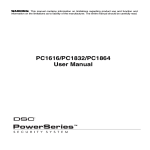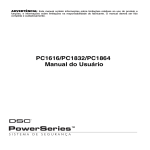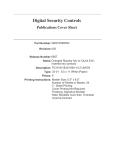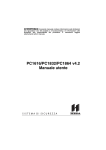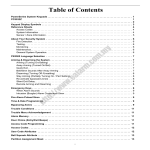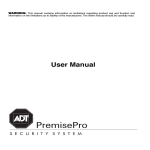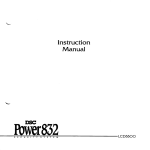Download DSC PowerSeries PC1832 System information
Transcript
DSC Power Series PC1616 PC1832 PC1864 General System Operation Your security system is made up of a DSC control panel, one or more keypads and various sensors and detectors. The control panel will be mounted out of the way in a utility closet or in a basement. The metal cabinet contains the system electronics, fuses and standby battery. All the keypads have an audible indicator and command entry keys. The LED keypads have a group of zone and system status lights. The LCD keypad has an alphanumeric liquid crystal display (LCD). The keypad is used to send commands to the system and to display the current system status. The keypad(s) will be mounted in a convenient location inside the protected premises close to the entry/exit door(s). The security system has several zones of area protection and each of these zones will be connected to one or more sensors (motion detectors, glassbreak detectors, door contacts, etc.). A sensor in alarm will be indicated by the corresponding zone lights flashing on a LED keypad or by written messages on the LCD keypad. Maintenance With normal use, the system requires minimum maintenance. Note the following points: Do not wash the security equipment with a wet cloth. Light dusting with a slightly moistened cloth should remove normal accumulations of dust. Use the system test described in “Testing Your System” to check the battery condition. We recommend, however, that the standby batteries be replaced every 3-5 years. For other system devices such as smoke detectors, passive infrared, ultrasonic or microwave motion detectors or glassbreak detectors, consult the manufacturer’s literature for testing and maintenance instructions. Arm and Disarm the System Arming (Turning On/Setting) Close all sensors (i.e. stop motion and close doors). The Ready (checkmark) indicator should be on. To arm, press and hold the Away key for two seconds and/or enter your Access Code, or press [*][0] to Quick Arm. During the setting state (exit delay active) the Armed (lock) and Ready (checkmark) indicators will turn on, and the keypad will sound one beep per second. To cancel the arming sequence, enter your access code. Away Arming (Turned On/Set) When the exit delay is completed, the alarm system is armed/set and this is indicated on the keypad as follows: the Ready (checkmark) indicator will turn off, the Armed indicator will remain on and the keypad will stop sounding. Quick Exit If the system is armed and you need to exit, use the Quick Exit function to avoid disarming and rearming the system. Press and hold the Exit key for two seconds or press [*][0]. You now have two minutes to leave the premises through your exit door. When the door is closed again, the remaining exit time is cancelled. Bell/Siren Sounds After Away Arming Audible Exit Fault In an attempt to reduce false alarms, the Audible Exit Fault is designed to notify you of an improper exit when arming the system in the Away mode. In the event that you fail to exit the premises during the allotted exit delay period, or if you do not securely close the Exit/Entry door, the system will notify you that it was improperly armed in two ways: the keypad will emit one continuous beep and the bell or siren will sound. Your installer will tell you if this feature has been enabled on your system. If this occurs: 1. Re-enter the premises. 2. Enter your [access code] to disarm the system. You must do this before the entry delay timer expires. 3. Follow the Away Arming procedure again, making sure to close the entry/exit door properly. Arming Error An error tone will sound if the system is unable to arm. This will happen if the system is not ready to arm (i.e., sensors are open), or if an incorrect user code has been entered. If this happens, ensure all sensors are secure, press [*] and try again. Disarming (Turning Off /Unsetting) Enter your access code to disarm anytime the system is armed (i.e., the Armed (lock) indicator is on). The keypad will beep if you walk through the entry door. Enter your code within the allotted time to avoid an alarm condition (please check with your installer to have this time programmed). Disarming Error If your code is invalid, the system will not disarm and a 2-second error tone will sound. If this happens, press [#] and try again. Stay Arming (Partially Turning On / Part Setting) Stay arming will bypass the interior protection (i.e., motion sensors) and arm the perimeter of the system (i.e., doors and windows). Close all sensors (i.e., stop motion and close doors). The Ready (checkmark) indicator should be on. Ask your alarm company if this function is available on your system. Press and hold the Stay key for 2 seconds and/or enter your Access Code and do not leave the premises (if your installer has programmed this button). During the setting state (exit delay active), the Armed (lock) and Ready (checkmark) indicators will turn on, and the keypad will sound one beep every three seconds. When the exit delay is completed, the alarm system is armed/set and this is indicated on the keypad as follows: the Ready (checkmark) indicator will turn off, the Armed (lock) indicator will remain on and the keypad will stop sounding. The Armed (lock) indicator and Bypass or System indicator will turn on. The system will automatically bypass certain interior sensors (i.e., motion sensors). Note: For SIA FAR listed panels, the Stay Arming Exit Delay will be twice as long as the Away Arming Exit Delay. Night Arming To fully arm the system when it has been armed in Stay Mode, press [*][1] at any keypad. All interior zones will now be armed except for devices programmed as Night Zones. Night zones are only armed in Away mode. This permits limited movement within the premises when the system is fully armed. Ensure that your installer has provided you with a list identifying zones programmed as night zones. When the interior zones have been activated (i.e., [*][1] you must enter your access code to disarm the system to gain access to interior areas that have not been programmed as night zones. Silent Exit Delay If the system is armed using the Stay button (Programmable Function Key) or using the "No Entry" Arming method ( [access code]), the audible progress annunciation (keypad buzzer) will be silenced and the exit time will be doubled for that exit period only. Remote Arming and Disarming The system can be armed and/or disarmed using the remote control device (wireless key) model DSC WS4939. When arming the system by using the Arm button on the wireless key, the system will acknowledge the command by sounding a single bell squawk. When disarming using the Disarm button on the wireless key, the system will acknowledge the command by sounding two bell squawks that can be heard from the exterior of the premises. Bypassing Zones Use the zone bypassing feature when you need access to a protected area while the system is armed, or when a zone is temporarily out of service, but you need to arm the system. Bypassed zones will not be able to sound an alarm. Bypassing zones reduces the level of security. If you are bypassing a zone because it is not working, call a service technician immediately so that the problem can be resolved and your system returned to proper working order. Ensure that no zones are unintentionally bypassed when arming your system. Zones cannot be bypassed once the system is armed. Bypassed zones are automatically cancelled each time the system is disarmed and must be bypassed again, if required, before the next arming. Note: For security reasons, your installer has programmed the system to prevent you from bypassing certain zones (e.g., smoke detectors). Bypassing Zones with a PK5500/LCD5500 Keypad Start with disarming the system. 1. Press [*] to enter the function menu. The keypad will display “Press [*] for < > Zone Bypass”. 2. Press [1] or [*] or , then your [access code] (if required). The keypad will display “Zone Search < > Zone Name”. 3. Enter the two-digit number of the zone(s) to be bypassed (01-64). You can also use the [< >] keys to find the zone to be bypassed, and then press [*] to select the zone. The keypad will display “Zone Search < > “Zone Name?”. “B” will appear on the display to show that the zone is bypassed. If a zone is open (e.g., door with door contact is open), the keypad will display “Zone Search < > “Zone Name” O”. If you bypass the open zone, a “B” will replace the “O”. 4. To unbypass a zone, enter the two-digit number of the zone(s) to be bypassed (01-64). You can also use the [< >] keys to find the zone, and then press [*] to select the zone. The “B” will disappear from the display to show that the zone is no longer bypassed. 5. To exit bypassing mode and return to the Ready state, press [#]. Bypassing Zones with a PK5500/LCD5500 Keypad Start with disarming the system. 1. Press [*][1], then your [access code] (if required). 2. Enter the two-digit number of the zone(s) to be bypassed (01-64). On PK5508/PK5516/PC55XXZ keypads, the zone light will turn on to indicate that the zone is bypassed. 3. To unbypass a zone, enter the two-digit number of the zone (01-64). On PK5508/PK5516/PC55XXZ keypads, the zone light will turn off to indicate that the zone is not bypassed. 4. To exit bypassing mode and return to the Ready state, press [#]. Activating All Bypassed Zones To activate all bypassed zones: 1. Press [*][1], then your [access code] (if necessary). 2. Press [0][0]. 3. To exit bypassing mode and return to the Ready state, press [#]. Recalling Bypassed Zones To recall the last set of bypassed zones: 1. Press [*][1], then your [access code] (if necessary). 2. Press [9][9]. 3. To exit bypassing mode and return to the Ready state, press [#]. Bypass Groups A Bypass Group is a selection of zones programmed into the system. If you bypass a group of zones on a regular basis, you can program them into the Bypass Group, so that you do not have to bypass each zone individually every time. One Bypass Group can be programmed on each partition. To program a Bypass Group: 1. Press [*][1], then your [access code] (if necessary). 2. Enter the two-digit numbers (01-64) of the zones to be included in the Bypass Group. On PK5500/LCD5500 keypads, you can also use the [< >] keys to find the zone to be included in the bypass group, and then press [*] to select the zone. 3. To save the selected zone into the group, press [9][5]. 4. To exit bypassing mode and return to the Ready state, press [#]. To select a Bypass Group when arming the system: 1. Press [1][*], then your [access code] (if necessary). 2. Press [9][1]. The next time the system is armed, the zones in this group will be bypassed. 3. To exit bypassing mode and return to the Ready state, press [#]. Note: Bypass Groups are only recalled if the system is armed/disarmed after programming the bypass group. This feature is not to be used in UL Listed installations. Door Chime (Entry/Exit Beeps) To turn the door chime function on or off, press and hold the Chime key for 2 seconds or press [*][4]. Panic Alarms Emergency Keys Press the [F], [A] or [P] key for 2 seconds to generate a Fire, Auxiliary or Panic alarm. The keypad sounder will beep indicating that the alarm input has been accepted and transmission to the central station is underway. Ask your alarm company if the emergency keys are available on your system. Note: The Fire keys can be disabled by the installer. LED5511/LCD5511 Keypad Press and hold both keys simultaneously for two seconds to send the following messages: [1][3] Fire Message [4][6] Auxiliary Message [7][9] Panic Message When Alarm Sounds The system can generate two different alarm sounds: Continuous Siren = Intrusion (Burglary Alarm) Temporal/Pulsed Siren = Fire Alarm Intrusion (Burglar) Alarm Continuous Siren If you are unsure of the source of the alarm approach with caution! If the alarm was accidental, enter your Access Code to silence the alarm. Call your central station to avoid a dispatch. Fire Alarm Pulsed Siren Follow your emergency evacuation plan immediately! If the fire alarm was accidental (i.e. burned toast, bathroom steam, etc.), enter your Access Code to silence the alarm. Call your central station to avoid a dispatch. Ask your alarm company if your system has been equipped with fire detection. To reset the detectors, see the Sensor Reset section. Trouble Conditions When a trouble condition is detected, the Trouble or System indicator will turn on, and the keypad will beep every 10 seconds. Press the [#] key to silence the beeps. Press [*][2] to view the trouble condition. The Trouble or System indicator will flash. The corresponding trouble will be represented by numbers 1-8. LED/Digit Trouble Condition Comments 1 Service Required (Press [1] for more information) (1) Low Battery (2) Bell Circuit (3) System Trouble (4) System Tamper (5) Modulate Supervision (6) RF Jam Detected (7) PC5204 Low Battery (8) PC5204 AC Failure 2 Loss of AC Power If the building and/or neighborhood has lost electrical power, the system will continue to operate on battery for several hours. 3 Telephone Line Fault The system has detected that the telephone line is cut. 4 Failure to Communicate The system attempted to communicate with the monitoring station, but failed. This may be due to Trouble 3. 5 Sensor (or Zone) Fault The system is experiencing difficulties with one or more sensors. 6 Sensor (or Zone) Tamper The system has detected a tamper condition with one or more sensors on the system. 7 Sensor (or Zone) Low Battery If the system has been equipped with wireless sensors, one or more has reported a low battery condition. 8 Loss of Time & Date If complete power was lost (AC and Battery), the time and date will need to be reprogrammed. Trouble Menu Acknowledgement If the Arming Inhibit for All Troubles features is enabled, Trouble Menu Acknowledgement may be used. To use this feature while in the Trouble Menu ([*][2]), press [9] to acknowledge and override the existing troubles, so the system can be armed. An override event will also be generated and logged, thus identifying the user. To override open zones, use the Zone Bypass feature ([*][1]). User Access Codes Access Code Programming In addition to the Master Access Code, you can program up to 32 additional User Access codes. Press [*][5], plus your Master Access Code. The Program or System indicator will begin to flash, and the Armed (lock) indicator will turn on. Enter the 2-digit number to be programmed (i.e., 06 for user access code 6; enter 40 for the Master Access Code). When using the PK5500/LCD5500, use the [< >] keys to find the specific code and press [*] to select. Enter the new 4digit access code, or press [*] to erase it. When programming is complete, enter another 2-digit code to program or press [#] to exit. For systems using multiple partitions/areas, access codes can be assigned to specific or multiple partitions/areas. Please contact your alarm company for details. The minimum number of variations of access codes (key) is 27027 when 37, 6-digit user codes are used. For SIA Installations, duplicate or duress codes derived from user codes +/- 1 digit are not allowed. The access codes have programmable attributes which allow zone bypassing, remote access using the ESCORT5580TC or one-time use activation. Access Codes [*][5][Master Code] (when disarmed) The [*][5] User’s Programming command is used to program additional access codes. User Codes (Access Codes 1-32) Master Code (Access Code 40) - The Master Code can only be changed by the Installer, if programmed. Supervisor Codes (Access Codes 41 & 42) - These codes are always valid when entering the User Code Programming section. However, these codes can only program additional codes which have equal or lesser attributes. Once programmed, the Supervisor Codes receive the Master Code’s attributes. These attributes are changeable. Duress Codes (Access Codes 33 & 34) - Duress codes 33 and 34 are standard User Codes that will transmit the Duress Reporting Code whenever the code is entered to perform any function on the system. Note: Duress codes are not valid when entering [*][5], [*][6] or [*][8] sections. No codes can be programmed as a duplicate of another code. Duress codes cannot be programmed as a duplicate or as a “Code + 1”. User Code Attributes The default attributes of a new code will be the attributes of the code used to enter [*][5] whether it is a new code or an existing code being programmed. System Master (Code 40) has Partition Access for all partitions, as well as Attributes 34 ON by default. Note: These attributes are not changeable. Inherent Attributes (all codes except installer and maintenance) Arm/Disarm - Any Access Code with Partition Access enabled will be valid for arming and disarming that partition. Command Outputs([*][7][1], [*][7][2], [*][7][3], and [*][7][4]) - If these outputs require Access Code entry, any Access Code with Partition Access will be valid for performing the [*][7][1-4][Access Code] functions on that partition. Programmable Attributes ([*][5][Master/Supervisor Code][9][Code]). 1. 2. 3. 4. 5. 6. 7. 8. For Future Use For Future Use Zone Bypassing Enabled ESCORT Access Downlook Remote Trigger to Phone Number 1 Downlook Remote Trigger to Phone Number 2 Bell Squawk upon Arming/Disarming One Time Use Code Note: Attributes 5 and 6 cannot be enabled on the same access code. Bell Squawk Attribuite This attribute is used to determine whether an access code should generate an arming/disarming Bell Squawk upon entry of the code for Away arming. The Wireless Keys with access codes associated with them may generate Arming/Disarming Bell squawks. If desired, this option may be used with codes that are manually entered. Please contact your installer to have this programmed. Note: The Master Code cannot use the Bell Squawk attribute, but is required to enable it for other codes. This feature cannot prevent the Arm/Disarming squawks from being generated if an access code assigned to a WLS Key is manually entered at a keypad. Partition Assignment Mask In order to accommodate Access Code Partition Assignment for the multiple partitions found on this product the user must enter [*][5][Master Code][8][Code number to be change] (ex. [*][5][1234][8][Code 03]. Under this section, each bit represents the corresponding partition’s access (i.e. Bit 4 represents Partition 4 access). The Master Code has access to all partitions, and cannot be modified. Partition Assignment Mask ([*][5][Master/Supervisor Code][8][Code]) 1. 2. 3. 4. 5. 6. 7. 8. Partition One Access Partition Two Access Partition Three Access Partition Four Access Partition Five Access Partition Six Access Partition Seven Access Partition Eight Access Notes on Access Codes and Programming 1. There will still be 37 codes if option selected for 6-digit access codes. o [*][5][MASTER CODE] [01 to 32, 33, 34, 40, 41, 42] to program access codes o [*][5][MASTER CODE][8] enters the Partition Assignment Mode [01 to 32, 33, 34, 41, 42] to edit access code partition assignments o [*][5][MASTER CODE][9] Enters the Attribute Mode [01 to 32, 33, 34, 41, 42] to edit access code Attributes 2. The Master Code’s attributes cannot be changed. 3. When a new code is programmed in [*][5] it will be checked against all other codes in the system. If a duplicate code is found, an error tone is given and the code is returned to what it was before it was changed. This applies to both 4 and 6-digit codes. Erasing an Access Code To erase a code, select the code and enter [*] as the first digit. If [*] is entered, the system will delete the code immediately and the user will be returned to select another code. User Function Commands First disarm the system then enter [*][6][Master Code]. The[*][6] command is used to gain access to the following list of Master functions of the system. 1. Time and Date - Enter four digits for 24 Hour System Time (HH-MM). Valid entries are 00-23 for the hour and 00-59 for minutes. Enter six digits for the Month, Day and Year (MM-DD-YY). 2. Auto-Arm Control - Pressing [2] while in the User Function menu will enable (three beeps) or disable (one long beep) the Auto-arm feature, by partition. With this feature enabled, the panel will automatically arm in the Away mode (Stay Away zones active) at the same time each day. The auto-arm time is programmed with the [*][6][Master Code][3] command. 3. Auto-Arm Time - The system can be programmed to arm at a programmed time each day, per partition. Upon entry of this section, enter 4 digits for the 24-hour Auto-arm time for each day of the week. At the selected auto-arm time, the keypad buzzers will sound for a programmed amount of time (programmable by the installer only) to warn that an auto-arm is in progress. The bell can also be programmed to squawk once every 10 seconds during this warning period. When the warning period is complete, the system will arm with no exit delay and in the Away Mode. Auto-arming can be cancelled or postponed by entering a valid access code only, during the programmed warning period. Auto-arming will be attempted at the same time the next day. When the auto-arming process is cancelled or postponed, the Auto-arm Cancellation Reporting Code will be transmitted (if programmed). If arming is inhibited by one of the following, the Auto-arm Cancellation transmission will be communicated. o AC / DC Inhibit Arm o Latching System Tampers o Zone Expander Supervisory Fault 4. System Test - The system’s Bell Output (2s), Keypad Lights and Communicator are tested. This test will also measure the panel’s standby battery. 5. Enable DLS/Allow System Service - If enabled, the installer will be able to access Installer Programming by DLS. In case of DLS access this provides a window where rings will be detected by the panel. The DLS window will remain open for six hours, during which time the installer will be able to enter DLS an unlimited number of times. After the six-hour window has expired, Installer’s Programming will be unavailable again until the window is re-opened. 6. User Call-Up - If enabled by the Installer, the panel will make 1 attempt to call the downloading computer. The downloading computer must be waiting for the panel to call before downloading can be performed. 7. Music Input On/Off - If enabled on the PC5936 Audio Interface Module, the user can turn Background Music on or off. 8. User Walk Test (For Europe only) - This test allows the user to verify operation of system detectors and notifies the central station that a Walk Test is in progress. Note: Fire zones, the [F] key, and 2-wire Smoke detectors are excluded from this test. Violation of these zones will cause the system to exit the walk test then generate and transmit alarm condition to the central station. 1. Press [*][6][8] to enable Walk Test. The system will notify the Central Station that a walk test has begun. 2. Violate all each detector (zone) in sequence. A squawk will occur at the keypad and the violation will be recorded in the Event Buffer. 3. Restore zones. Press [*][6][8] to end the Walk Test. The system will notify the Central Station that the walk test has been terminated. Note: If a zone is not violated within 15 minutes of activating the Walk Test, the system will automatically exit the Walk Test and resume normal operation. System Testing Testing Your System Testing Your Keypad Sounder and Siren The System Test provides several system tests, and a two-second check of the keypad sounder and bell or siren. 1. Press [*][6] [Master Code] [4]. 2. The following will occur: o The system activates all keypad sounders and bells or sirens for two seconds. All keypad lights turn ON. o PK5500/LCD5500 keypads will light all pixels. o The Ready, Armed, and Trouble LED’s will flash for the duration of the test. 3. To exit the function menu, press [#]. Testing Your Entire System All smoke detectors in this installation must be tested by your smoke detector installer or dealer once a year to ensure they are functioning correctly. It is the user’s responsibility to test the system weekly (excluding smoke detectors). Ensure you follow all the steps in the ‘Testing Your System’ section above. Note: Should the system fail to function properly, call your installation company for service immediately. 1. 2. 3. 4. Prior to testing, ensure that the system is disarmed and the Ready light is on. Press [#] and close all zones to return the system to the Ready state. Perform a System Test by following the steps in the previous section. To test the zones, activate each detector in turn (e.g., open each door/window or walk in motion detector areas). PK5500/LCD5500 keypads will display the following message when each zone (detector) is activated: “Secure System Before Arming < >”, “Secure System or Enter Code” or “Secure or Arm System”. Use the [< >] keys to view which zones are open. The message will disappear when the zones are closed. On an PK5501/LCD5501Z keypad, the display says “Open” when any zone (detector) is activated. To see which zones are open, press [#]. The keypad will scroll the numbers of all open zones. On a PK5508/PK5516/PC55XXZ keypad, the zone light turns on when the zone (detector) is activated. The zone light turns OFF when the zone is closed (e.g., door or window closed). Note: Some features described above will not be functional unless enabled by your installer. Ask your installer which features are functional on your system. Walk Test Mode The installer can initiate a Walk Test mode for the system. While in Walk Test mode, The Ready, Armed, and Trouble LED's will flash to indicate that Walk Test is active. When the system automatically terminates the Walk Test modes, it will annunciate with an audible warning (5 beeps every 10 seconds), beginning five minutes prior to the termination of the test. Allowing Computer Access to Your System From time to time, your installer may need to send information to or retrieve information from your security system. Your installer will do this by having a computer call your system over the telephone line. You may need to prepare your system to receive this ‘downloading’ call. Press [*][6][Master code][5] at any keypad. This allows downloading for a limited period of time. During this time, the system will answer incoming downloading calls. Other System Information Language Selection Your keypad may have the capability to display messages in different languages. 1. Press and hold both [< >] keys simultaneously. 2. Using the [< >] keys, scroll through the available languages. 3. Press [*] to select your desired language. Time & Date Programming Press [*][6], plus your Master Access Code or press the time programming function key (programmed by your installer). Press [1] to select Time and Date. When using the PK5500/LCD5500, use the [< >] scroll keys to find the menu option and press [*] to select. Enter the time in 24-hr format (HH:MM), followed by the date (MM:DD:YY). Press [#] to exit programming. Note: If you have an LCD keypad, your installer may have programmed your system to display the time and date while the keypad is idle. If this is the case, you can press the [#] key to clear the date and time display. Alarm Memory When an alarm occurs, the Memory or System indicator (and Fire indicator, if applicable) will turn on. To view which sensor(s) generated the alarm, press [*][3]. The Memory or System indicator and corresponding sensor number will flash (i.e., sensor 3). For the PK5500/LCD5500 keypad use the [< >] scroll keys to view the sensors in alarm memory. Press [#] to exit. To clear the memory, arm and disarm the system. If an alarm sounded while armed, the keypad will automatically go to alarm memory when you disarm the system. In this instance, you should approach with caution, as the intruder may still be within the building/premises. Changing Brightness/Contrast PK5500/LCD5500 When this option is selected, the keypad will allow you to scroll through 10 different brightness/contrast levels. 1. Press [*][6][Master code]. 2. Use the [< >] keys to scroll to either Brightness Control or Contrast Control. 3. Press [*] to select the setting you want to adjust. 4. o ‘Brightness Control’: There are multiple backlighting levels. Use the [< >] keys to scroll to the desired level. o Contrast Control’: There are 10 different display contrast levels. Use the [< >] keys to scroll to the desired contrast level. 5. To exit, press [#]. Changing the Buzzer Level PK5500/LCD5500 When this option is selected, the keypad will allow you to scroll through 21 different buzzer levels. A level of 00 disables the buzzer. 1. Press [*][6][Master Code]. 2. Use the [< >] keys to scroll to Buzzer Control. 3. There are 21 different levels, use the [< >] keys to scroll to the desired level. PK5501/PK5508/PK5516 1. Press [*][6][Master Code]. 2. Use the [<] key to scroll to move through the 21 different buzzer levels. 3. The level is automatically saved when you press [#] to exit. Label Programming PK5500/LCD5500 When this option is selected, the keypad will allow you to program labels representing zones, partitions, and command outputs. Also, special labels can be added to show when the system fails to arm or when you disarm after an alarm has occurred. 1. 2. 3. 4. Press [*][6][Master Code]. Use the [< >] keys to scroll to Edit Labels. Use the [< >] keys to select the label type you want to edit. Use the [< >] keys to select the individual label you want to edit. 5. Use the arrow keys ([< >]) to move the underline bar underneath the letter to be changed. 6. Press the number keys [1] to [9] corresponding to the letter you require. The first time you press the number the first letter will appear. Pressing the number key again will display the next letter. Refer to the following: [1] - A, B, C, 1 [2] - D, E, F, 2 [3] - G, H, I, 3 [4] - J, K, L, 4 [5] - M, N, O, 5 [6] - P, Q, R, 6 [7] - S, T, U, 7 [8] - V, W, X, 8 [9] - Y, Z, 9, 0 [0] - Space 7. When the required letter or number is displayed use the arrow keys ([< >]) to scroll to the next letter. 8. When you are finished programming the Zone Label, press the [*] key, scroll to “Save,” then press [*]. 9. Continue from Step 2 until all Labels are programmed. Viewing the Event Buffer from a PK5500/LCD5500 Keypad The event buffer will show you a list of the last 500 events that have occurred on your system. You must use an LCD keypad to view the event buffer. 1. Press [*][6][Master Code]. 2. To select Event Buffer viewing, press [*]. 3. The keypad will display the event number, partition or area, and the time and date. Press [*] to switch between this information and the event details. 4. Use the [< >] keys to scroll through the events in the buffer. 5. To exit event buffer viewing, press [#]. PK5500 Global Status Screen When the keypad is loaned to global mode (pressing and holding the [#] key), you will see a Global Partition Status screen. This shows basic status for up to 8 partitions, depending on the configuration of your system. Each partition is identified by a number. Below each number is the current status of that partition. A - Partition is Armed N - Partition is Not Ready to Arm R - Partition is Ready to Arm ! - Partition is in Alarmed - - Partition is Not Enabled Sensor Reset Certain sensors, after having detected an alarm condition, require a Reset to exit the alarm condition (i.e. glassbreak sensors, smoke detectors, etc.). Ask your alarm company if this function is required on your system. To reset the detectors, press and hold the Reset key for 2 seconds or press [*][7][2]. If a sensor fails to reset, it may still be detecting an alarm condition. If the sensor reset is successful, the alarm is cancelled. If unsuccessful, the alarm will reactivate or continue.














